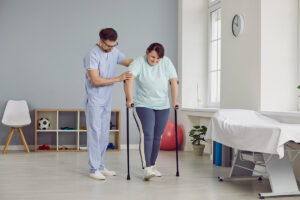Post-Accident Gait and Balance Problems | Treatment Options
 A common outcome of various traumatic injuries, including traumatic brain injuries, is a struggle with gait (walking pattern) or balance. How do injuries sustained in motor vehicle accidents or a slip-and-fall impact your mobility and stability?
A common outcome of various traumatic injuries, including traumatic brain injuries, is a struggle with gait (walking pattern) or balance. How do injuries sustained in motor vehicle accidents or a slip-and-fall impact your mobility and stability?
Key Factors Influencing Gait and Balance Issues
Balancing and walking, though seemingly simple, require the coordinated effort of various body parts.
- Bones: Each foot comprises 26 bones, all vital for balance and movement. The leg bones provide primary support for walking and standing. Even a minor fracture can significantly hinder weight-bearing and affect balance.
- Connective tissue: The thighs, calves, and feet comprise over 100 crucial muscles, ligaments, and tendons. Traumatic injuries can cause tears or bruising, resulting in inflammation, tenderness, or stiffness. These issues can negatively affect both balance and gait.
- Joints: The lower body has over 30 joints bound by connective tissue. Compromised joints can jeopardize stability, making walking or standing a risky undertaking.
- The brain: As the body’s command center, the brain coordinates communication among muscles, ligaments, and tissues, facilitating the subtle adjustments needed for seamless walking and standing. Even a mild traumatic brain injury can interfere with this communication, resulting in gait and balance issues.
Options for Treating Gait or Balance Problems Caused by Injury
The approach to addressing gait or balance problems depends on the nature and severity of the injury:
- Fractures: Consult an orthopedic specialist for appropriate treatment. This may involve casting, prescribing a boot or shoe, or, in some cases, surgical intervention for proper healing.
- Gait issues: Physical therapy is often the best course of action. Working closely with a specialist can help rebuild muscle strength, reduce inflammation, and improve flexibility and range of motion.
- Traumatic brain injury: Consult your primary care physician for an initial assessment. They can provide a care plan or refer you to a specialist such as a neurologist or physiatrist.

